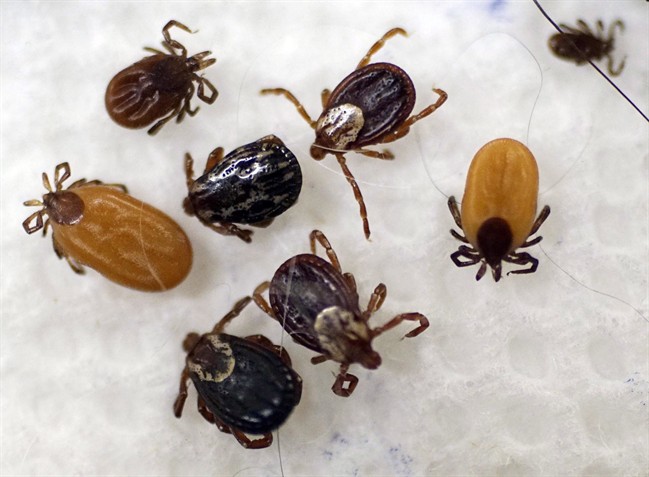Warm weather means more time spent outdoors enjoying nature, but it also means more potential interactions with some of nature’s less-friendly critters — like ticks.

Manitobans emerging from isolation are noticing more and more of the hungry little bloodsuckers, but ticks can be more than just an annoyance — they can spread Lyme disease and other illnesses.
“There are the two main ones that people usually call the wood tick — that’s the one that’s golden brown with either the two little white stripes or a nice little white circle on it, and then you have the black-legged tick, which has the black legs and of course very defined black spots behind its head,” entomologist Taz Stuart of Poulin’s Exterminators told 680 CJOB.
“The black-legged tick is more dangerous. Most people relate the black-legged tick — or the deer tick — with Lyme disease and other serious illnesses that can affect humans.”
Stuart said the black-legged ticks are active from snowmelt to snowfall, and that while many people are familiar with the adults, they may not be aware that the tiny nymph ticks can be a threat as well.
“They’re about the size of a poppy seed,” he said. “They get into those nether regions — those sensitive little spots along your hairline, in behind your back, your armpits, behind your legs. So when you go out into grassy areas, ticks love to wait on tree lines, grass lines, etc.
“They’re tiny, and that’s the most dangerous stage.”
Stuart said there are a few methods to keep yourself safe from the insects, and the first might not appeal to those who like to spend their summer outdoor time in bare feet.
“It’s the geek look, I hate to say it, wearing long pants and putting the socks over the top. Also, wearing DEET — spraying it on your clothes, on your person — and then doing that personal check when you come back inside.”

Many Manitobans, he said, aren’t clear on the best and safest method to remove a tick.
Stuart said he’s heard people say they use matches, or lighters, or put Vaseline on the ticks to get them off their bodies, but none of those are effective methods.
“What you need to be using is tick keys, or taking a pair of forceps or tweezers… going directly at a 90-degree angle to the tick, right to the level of the skin, and slowly pull it out.
“You want to pull out those mouthparts so they don’t stay in you. Doing those other methods, you might leave them behind and that can cause other issues.”
- Canadian man dies during Texas Ironman event. His widow wants answers as to why
- ‘Sciatica was gone’: hospital performs robot-assisted spinal surgery in Canadian first
- Canadians more likely to eat food past best-before date. What are the risks?
- Treatment from female doctors leads to lower death rates, study finds
If you’ve discovered a tick on your body and you think it’s of the potentially dangerous black-legged variety, the province has a Tick Checker service, where Manitobans can submit photos online of ticks they find.
The program, operated by Manitoba Health, Seniors and Active Living, isn’t intended to give any medical diagnosis of potentially tick-borne illnesses, but will notify people of next steps if they’ve found a black-legged tick.
“The purpose of the passive surveillance program is to help guide active surveillance efforts and to gain further information about the distribution of black-legged tick populations, activity periods and the presence of tick-borne diseases,” the health department says on the site.
“You may be asked to submit your tick specimen for further identification and testing, and if so additional information will be provided.”
Identified specimens are then submitted to the National Microbiology Laboratory for testing.









Comments